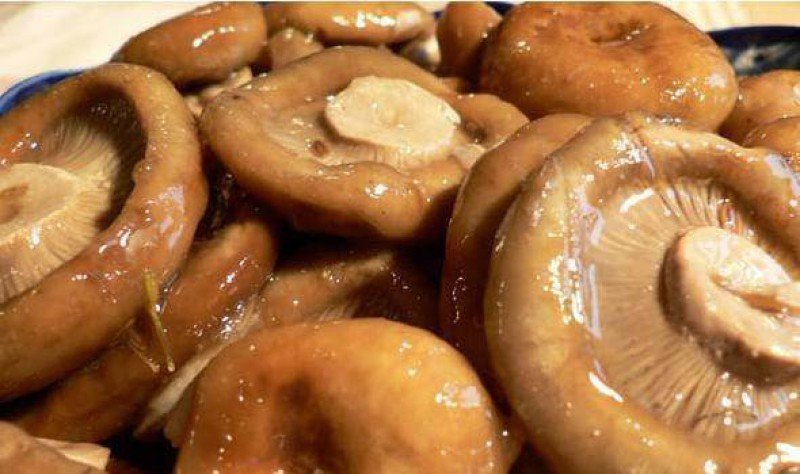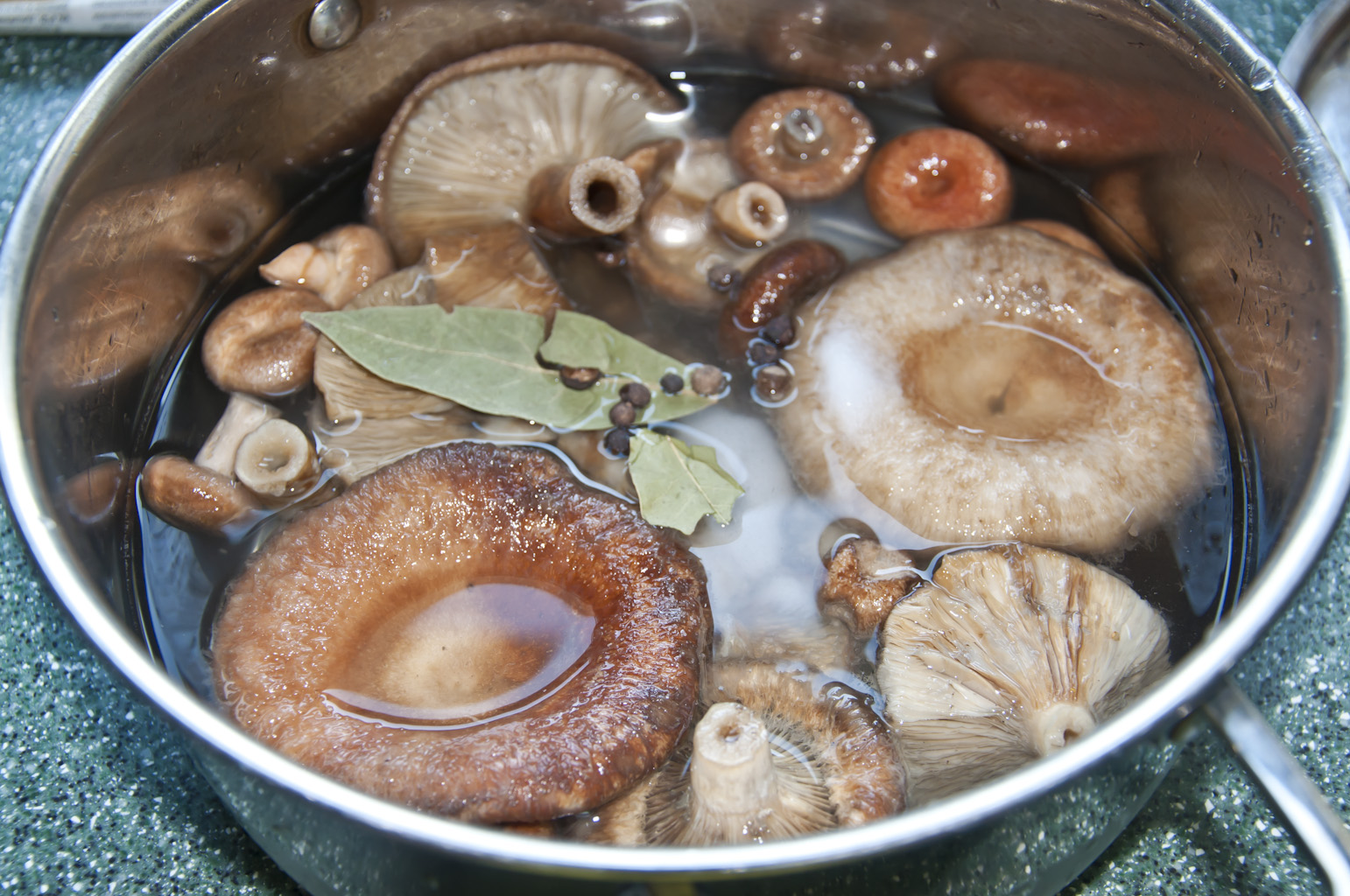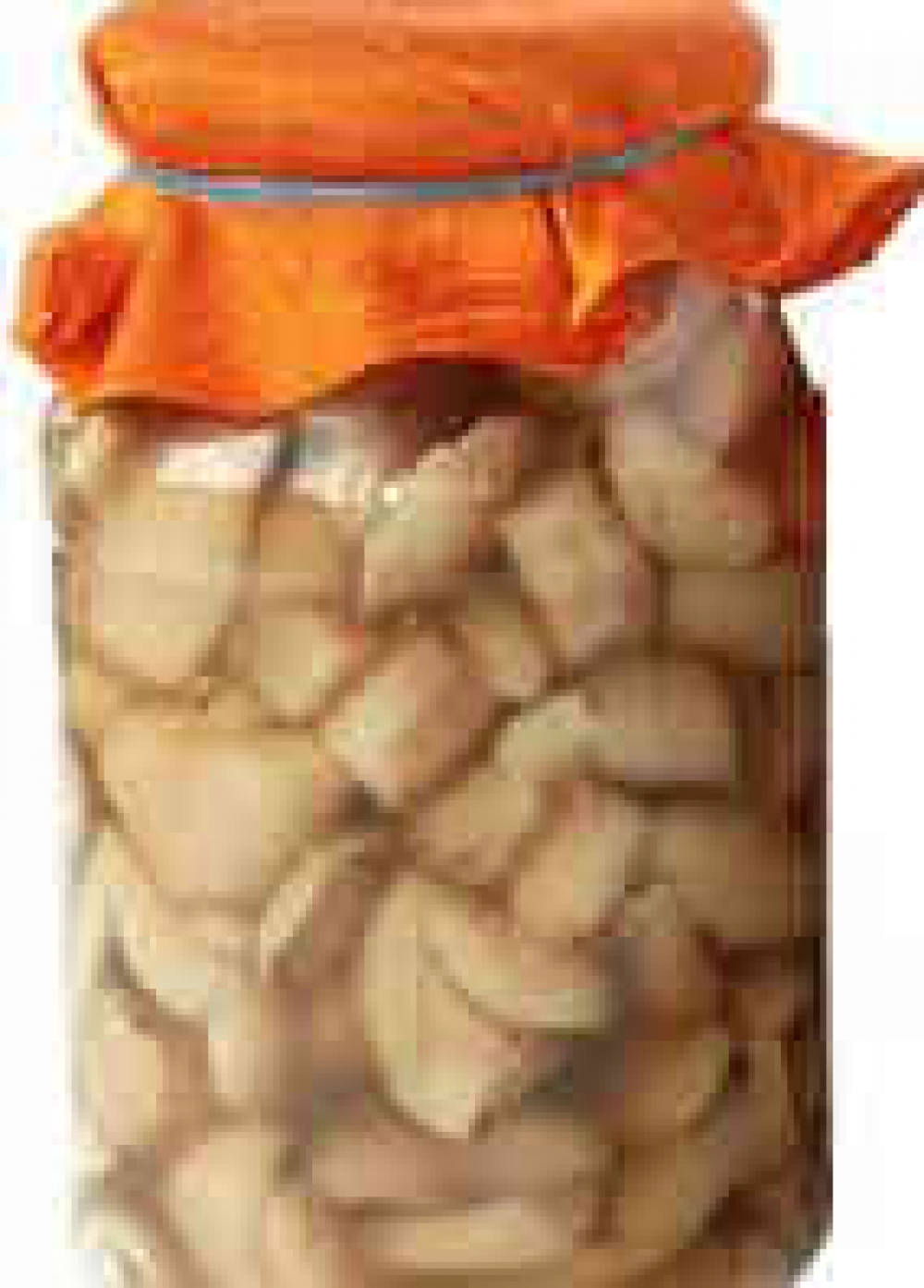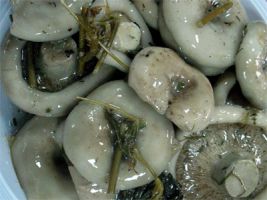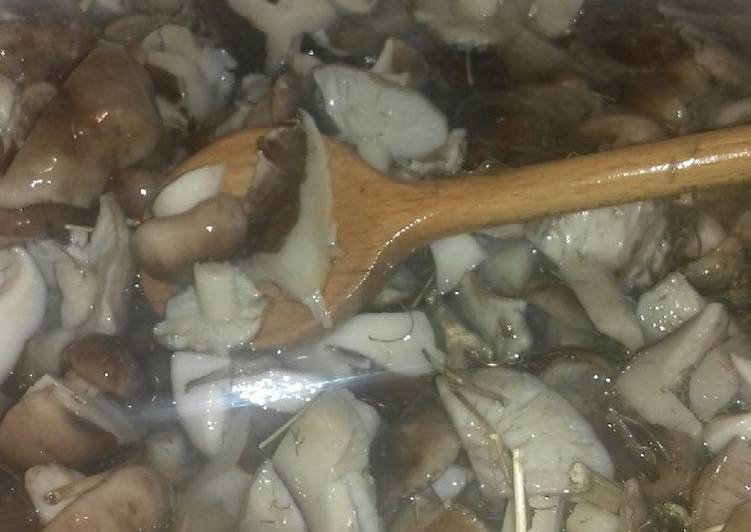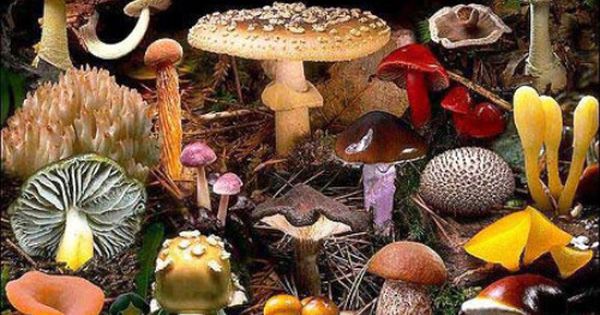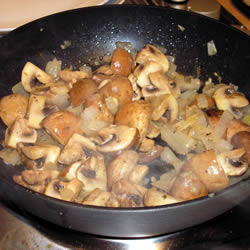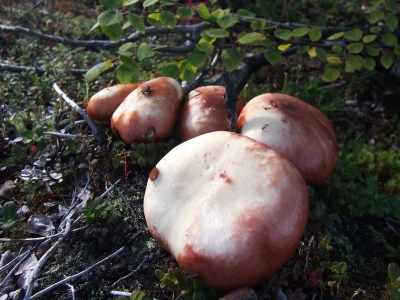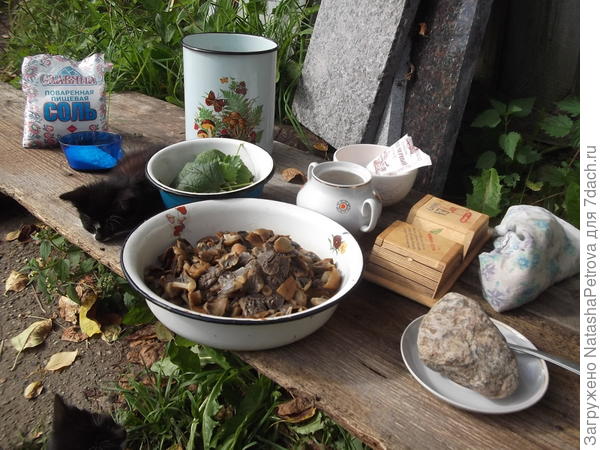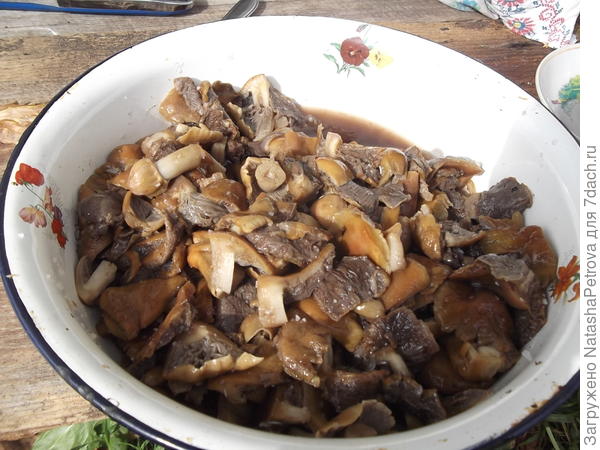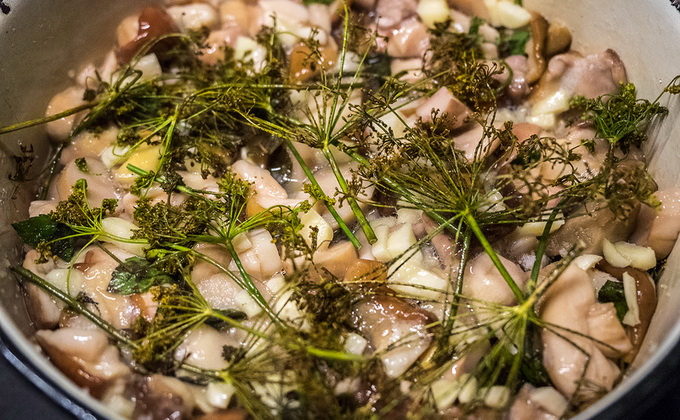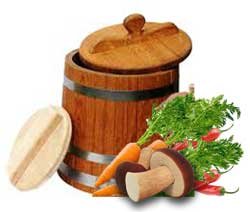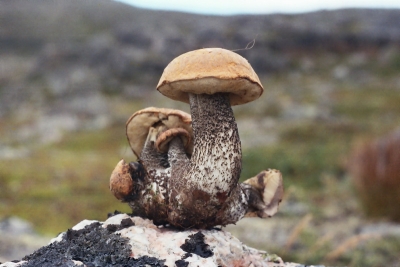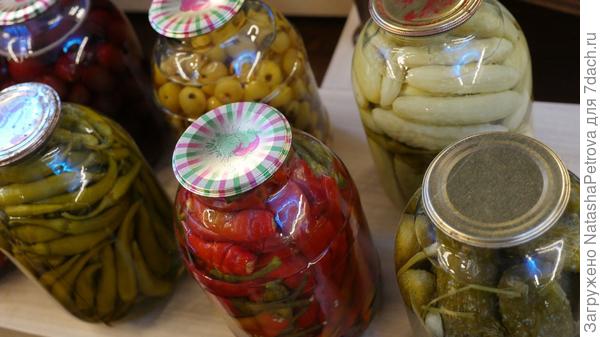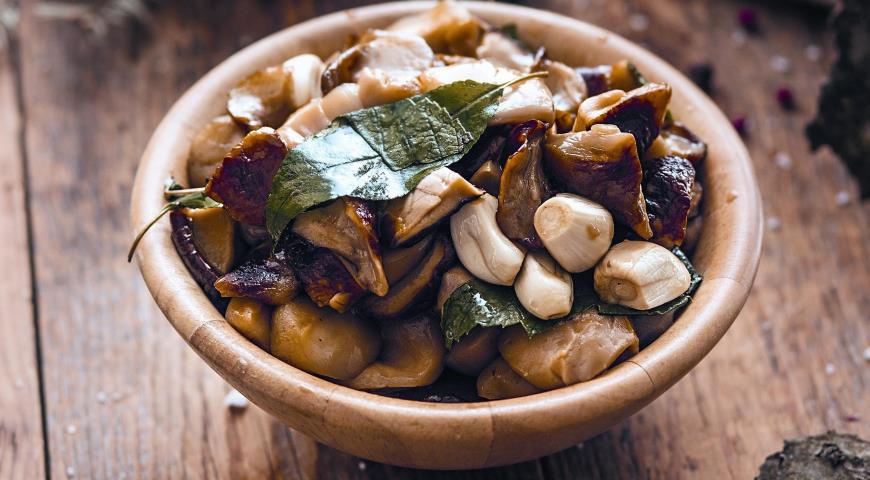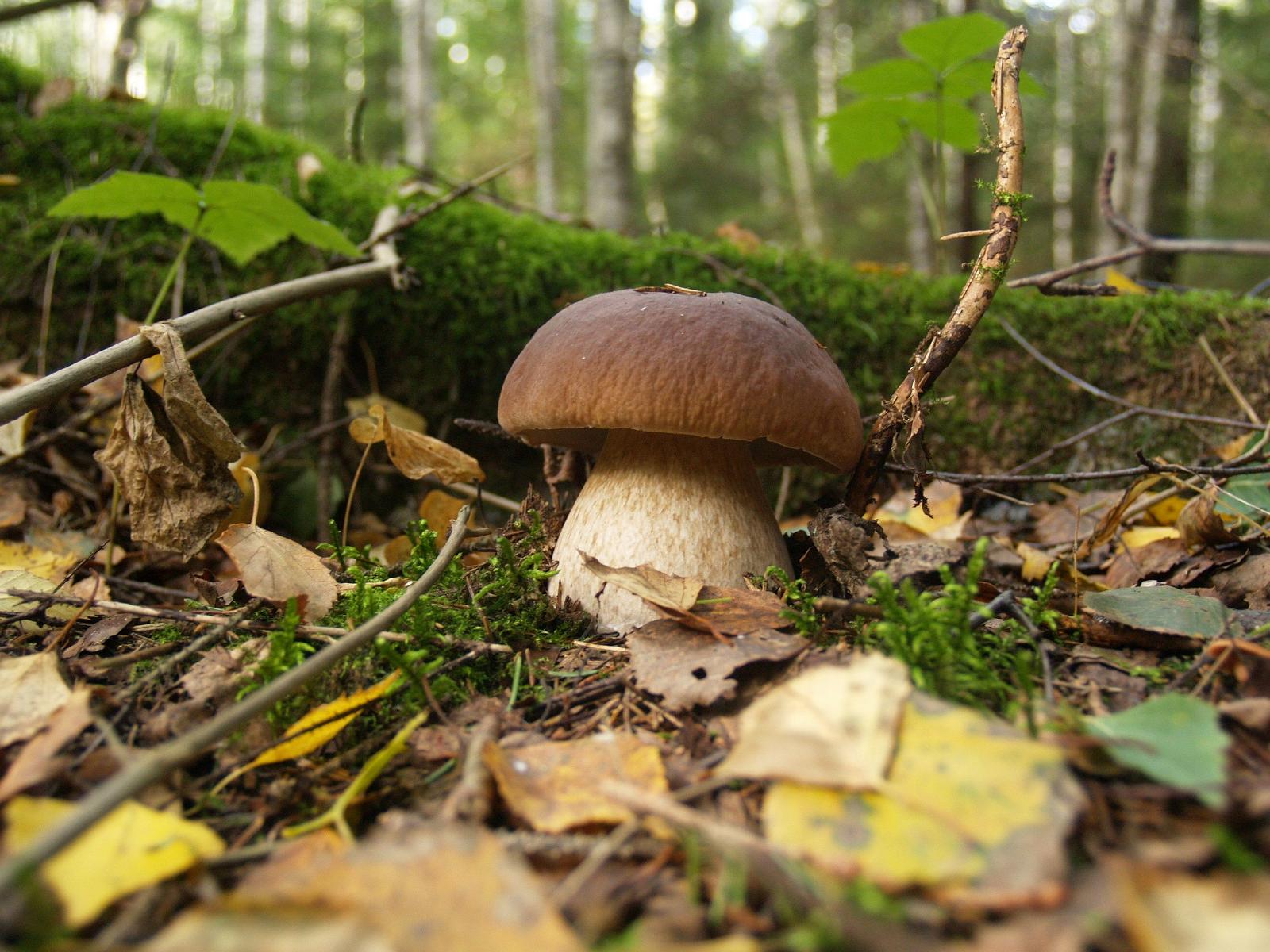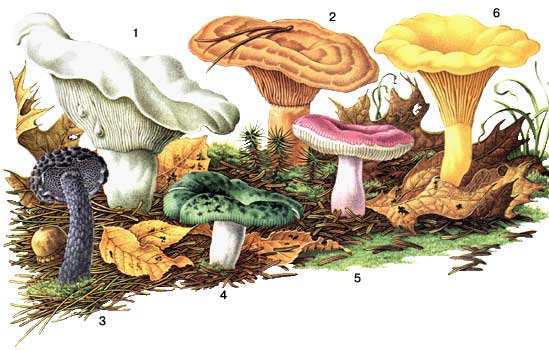Delicious recipes for making pickled mushrooms for the winter

Recipes of pickled mushrooms for the winter will be useful for every owner to know, because a wonderful aromatic dish will always appeal to both during a daily feast and during a festive one. Oyster mushrooms, mushrooms, mushrooms, mushrooms, pigs, russula, boletus and many other varieties of mushrooms are suitable for rolling in jars for the winter. All that remains is to cook them deliciously and correctly.
Mushroom preparation
Before pickling mushrooms in jars for the winter, it is important to make sure that the collected specimens do not cause household illnesses. For good preservation of mushrooms, you need to be able to prepare them for conservation.
It is important to know that mushrooms are harvested in dry weather, and put in a basket, clearing of soil and debris. And you also need to monitor compliance with all the rules of the conservation process, for example, the usual procedure for boiling cans will not help to cope with botulism.
Porous organisms die only at temperatures above 120 degrees, and such conditions can only be created in an autoclave.
Before pickling, you need to sort the mushrooms and boil. Of course, the cooking time for each variety will vary. For example, boletus, boletus and aspen mushrooms need 15 minutes processing, and porcini mushrooms need 25 minutes.
Autumn species: chanterelles and mushrooms require half an hour of cooking, and it would be better to separate the legs, hats and cook separately. This is done because the legs are denser and take longer to cook.
There are some nuances in preparing mushrooms for pickling in jars for the winter. So that the boletus ceases to taste bitter, you need to rid them of the sticky skin and wash each mushroom under the tap. Before salting boletus and brown boletus, pour boiling water over them for ten minutes, and then rinse with cool water. This is done so that the mushrooms and marinade themselves do not turn black after pickling.
Pickles and marinade recipes
An appetizer of pickled and salted mushrooms is always very welcome on the festive table. The blanks are distinguished by a spicy taste that is very difficult to compare with any other. However, poorly prepared or improperly harvested mushrooms are often the cause of poisoning. If you have doubts about your own abilities, then it is better to purchase a delicious snack in the store.
Option for boletus
Boletus or porcini mushroom is the most valuable and delicious type of "forest gifts". Its unique taste and ability to improve the functioning of the human digestive system make the specimen unique.
The benefits of the mushroom for a person suffering from stomach pains are sometimes much greater than from traditional chicken and meat broths. The product is rich in protein, copper, iodine, manganese and zinc. It disinfects well, helps to cope with infectious diseases.
Porcini mushrooms pickled in a fragrant base will be the perfect snack on every table.
A bit of theory
Throughout human history, the need to increase the shelf life of food is a vital issue. Given the current state of the food industry in developed countries, of course, its ability to survive does not depend on whether a family can stock up on provisions for the winter.
However, canning and homemade, including, is still relevant. Despite the development of technology, only four fundamental principles of food preservation are known:
- bios - storage of fruits and vegetables without special processing, only when conditions are created that support normal life processes in fruits, with a limitation of their intensity. Natural resistance to pathogenic microorganisms is used. According to the bios principle, potatoes, various root crops, pumpkins and more are stored in the cellar. In addition to vegetables and fruits, other products are stored through bios, for example, bird eggs.
- suspended animation - storage at low temperatures.In the cold, the vital activity of bacteria, which destroys food, slows down, up to a complete stop.
- abiosis - the creation of conditions leading to the death of harmful microorganisms. These conditions - for example, high or low temperatures, creating an acidic environment (pickling), disturbance of cellular osmosis - when using salt or sugar, anaerobic (airless) environment. With this method, after the destruction of microorganisms that lead to food spoilage, it is required to ensure the safety of the product from new contamination by microorganisms, that is, to place it in a sterile sealed environment.
coenobiosis - this method of preserving food consists in cultivating beneficial microflora, which, by its active development and processes occurring as a result of its vital activity, suppresses the development of pathogenic microbes and bacteria and makes their existence impossible. Fermentation and fermentation are related to coenobioses.
All canning methods used both on an industrial scale and with homemade preparations are, in one way or another, based on these four principles or their combinations.
Features of the process depending on the type of product
Each mushroom has its own characteristics in fermentation. Mushrooms that do not need to be soaked:
- Ezhoviks.
- Ryzhiki.
- Russula.
- Rows.
- Goats.
Some types of mushrooms can be salted together, for example:
- Milk mushrooms.
- Waves.
- Russula.
- Ryzhiki.
- Loading.
Some mushrooms are boiled, for example:
- Serushki.
- Waves.
- Bitter milk mushrooms.
- Blackies.
- Violinists.
For cold sourdough without soaking, mushrooms are used such as:
- Brown birch trees.
- Butterlets.
- White mushrooms.
- Talkers.
- Ryzhiki.
- Chanterelles.
- Russula.
For fermentation with preliminary soaking, take mushrooms such as:
- Burning russula.
- Bitter milkmen.
For hot fermentation, use:
- Russula.
- Rows.
- Bitter milk mushrooms.
- Honey mushrooms.
- Tubular mushrooms.
- White mushrooms.
Salted mushrooms for the winter. Hot and cold recipes

We continue a series of articles on mushroom preparations for the winter. In previous articles, we got acquainted with the methods of pickling honey agarics. Now I will review the recipes for making salted mushrooms. If you have not picked mushrooms this year, then hurry up, as they will be gone with the onset of cold weather.
It is important to note that mushrooms cannot be stored for a long time without processing, so they must be salted immediately after returning from the forest. They must be sorted out, discarded wormy and broken mushrooms, and, if possible, select the same size
Today we will look at two ways to prepare a winter snack: hot and cold. The latter is considered classic, but it takes more time.
So let's start reviewing the recipes ...
Hot salted mushrooms in 1 or 2 liter jars
This option for preparing mushroom snacks from honey agarics is the simplest and safest. After such processing, the mushrooms can be stored for one year.
Ingredients:
- 2 kg of fresh mushrooms.
- 12 bay leaves.
- 60 g table salt.
- 10 cloves of garlic.
- 3 dill umbrellas.
- 10 allspice peas.
For brine for 1 liter of water:
- 3 pieces of lavrushka.
- 7 pcs of cloves.
- 7 peas of black pepper.
Cooking process
Small mushrooms are better suited for salting. If you have collected large forest mushrooms, then they will have to be cut into several pieces. To begin with, you need to carefully sort out, clean well of dirt and rinse 2-3 times.
In large mushrooms, we separate the legs from the caps, and small mushrooms can be harvested whole. Put in a large container, pour running water and salt it. Send to the burner, and after the liquid boils, cook for no more than five minutes. The resulting foam must be removed.
The cooked mushrooms should be rinsed in a colander and left to drain all the liquid. Then transfer them to a separate bowl.
Peel the garlic and cut into small slices. Send the dill umbrellas in an enamel container.
Then lay out a small layer of mushrooms, add salt and the necessary spices. In the same way, lay out several layers, and pour on top with prepared brine (1 glass).
Cover the honey mushrooms with a plate, and put a load on top (a saucepan or a jar of water). Under pressure, the mushrooms should be completely immersed in the brine. If there is not enough liquid, then you will need to add a little.
If you do not have a cellar, then it is better to keep the snack in the refrigerator. But after a year, they are not recommended to be eaten, as salted mushrooms can cause food poisoning or upset.
Cold salted mushrooms in jars
If you want a mushroom appetizer to be flavorful and crispy, it's best to use the cold cooking method. This alone will take a long time, so please be patient.
Ingredients:
- 1 bucket of honey mushrooms.
- Garlic.
- Dill umbrellas.
- Horseradish leaves.
- Black peppercorns.
- 200 g table salt.
Salting method
Honey mushrooms need to be cleaned, cut off the legs, since they are tough, we will not use them. Pour the hats with salted water for 3 days. This procedure allows you to get rid of the bitter taste.
Refresh water daily, otherwise honey mushrooms will deteriorate. It is advisable to soak the mushrooms in a wooden barrel, but if you do not have this opportunity, then you can use a plastic bowl or a large pan.
Add washed horseradish leaves and chopped root to a wooden tub. You can use cherry or currant leaves if desired. Add chopped garlic, dill umbrellas and peppercorns. Then lay out a layer of mushrooms to be salted.
Thus, several layers need to be laid out. Then it is necessary to install oppression from above. Remove mushrooms in a cool and dark place for 2 months. Periodically, you need to check if the appetizer has deteriorated.
It is recommended to store salted mushrooms in the cellar. If you do not have this opportunity, then send them to the refrigerator. Before use, it is recommended to add onion rings and vegetable oil to honey mushrooms.
Sauerkraut as an alternative to marinade
During the harvesting season, salt and sugar are transformed from strategic products into tactical ones: kilograms of them are “spent” on jams and pickles. Another ingredient that is equally popular with housewives for home canning is vinegar. As you know, microbes do not survive in an acidic environment. Therefore, when preserving, organic acids are used - vinegar, citric acid.
Acid Acid Strife
But excessive acidity is dangerous not only for harmful microorganisms, but also useful, for example, the microflora of our stomach. The abuse of pickled cucumbers or mushrooms can negatively affect the condition of even a healthy person, what can we say about ulcers. The fermentation process is based on the activity of lactic acid bacteria, the result of which is lactic acid, which becomes a preservative - in the resulting acidic environment, other bacteria do not multiply. And lactic acid is a much more gentle option for the stomach than vinegar. Moreover, lactic acid bacteria (genus Lactobacillales) also include representatives of Lactobacillus acidophilus, which are part of the microflora of the human stomach and some other mammals and directly affect human life and health. Acidophilic (acid-loving) bacteria are used for the production of medicinal preparations - probiotics (preparations containing live cultures of lacto and bifidobacteria). Preparations containing cultures of lactic acid bacteria are used for gastrointestinal disorders, treatment of diarrhea, for strengthening and enhancing immunity. This means that it turns out that lactic acid in canning is more useful than acetic acid.
Vinegar digression
In fairness, it should be noted that vinegar is also not only a popular seasoning, but also a medicine - it is an excellent antiseptic, and it is used to fight various infections.However, this applies only to natural vinegar - a product of ethyl alcohol oxidation by acetic acid bacteria: grape, apple, rice, malt and others. Synthetic acetic acid is produced not by acetic acid bacteria, but by chemists - in one of the industrial production methods, synthetic acetic acid is a by-product in the production of fertilizers.
But do all the housewives have a bottle of apple cider vinegar in the buffet, moreover natural, and not the same aqueous solution of synthetic acetic acid with the chemical flavoring "Apple"? On culinary forums, recommendations are given on how to dilute vinegar essence to obtain 6-9% table vinegar, and in many recipes it is directly indicated how much undiluted vinegar essence should be taken for a particular volume when preparing a marinade. Meanwhile, in many countries, the use of vinegar essence for food purposes is prohibited. And the taste of vegetable salads, cucumbers or mushrooms with a marinade of synthetic vinegar deteriorates during storage: the acid levels the taste of the dish, washing it off.
Souring and urinating
Strictly speaking, today there is no difference between pickling and pickling: salt is also used for pickling. Therefore, this method of canning uses two preservatives - salt and lactic acid. In the classic pickle recipe, there is a fermentation stage. It is customary to distinguish between salty canned foods by the concentration of salt in solution:
- 6-8% and more - pickles;
- 2.5-3% - fermented product;
- 1-2% salt and sugar is added to the solution - urination.
Traditionally, cucumbers are considered salted, cabbage - sauerkraut, and apples - pickled. Although the ancestors fermented without the use of salt - and cabbage, and cucumbers, and mushrooms - salt was expensive. Healthy eating advocates such as Paul Bragg advise against using salt in pickling, such as cabbage.
Rice-millet porridge with sauerkraut

Category:
Cooking in a multicooker Dishes from cereals and legumes in a multicooker Dishes from cereals in a multicooker
Once, when I was visiting Ukraine, I watched from the sidelines an experienced cook as she cooked an unusual porridge for a large number of people. Of course, to prepare this porridge, she used sauerkraut and her own butter, homemade milk and thick sour cream, eggs. And when this porridge was served on the table, all the guests immediately emptied their plates - this porridge was so tasty! About 14 years have passed, and I could not forget the taste of this porridge, but I could not get the recipe. I searched the Internet, asked my relatives from Ukraine, but to no avail. And so, especially for this project, my relative contacted the same cook and gave me a recipe for this porridge by phone. My joy knew no bounds! In Ukraine, this porridge is served, generously poured with fried lard and onions, but we liked the porridge even without it.
Preliminary preparation
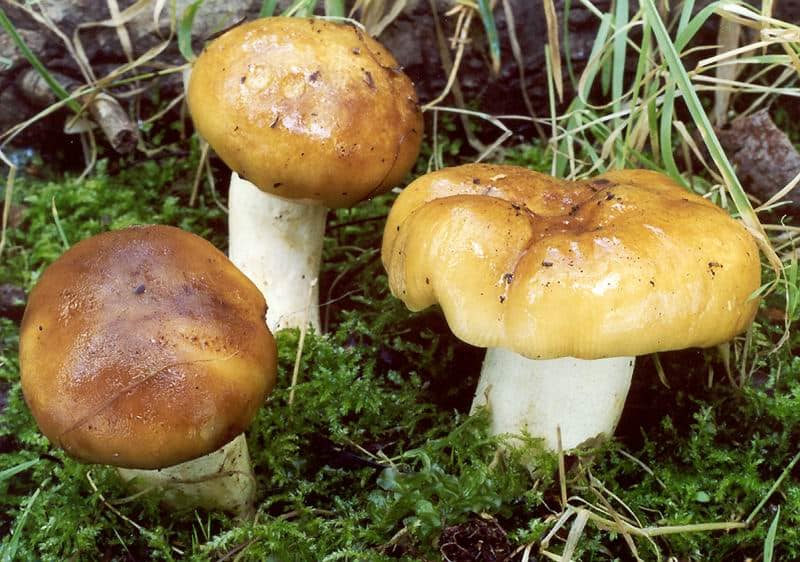
The preparation of the value must necessarily begin with the preliminary preparation of the fruit chalk. It allows you to improve the nutritional and taste qualities of the product, to remove the milky juice, which gives the mushroom bitterness, to rid it of harmful substances.
Value processing begins with cleansing. To do this, the freshly harvested crop is sorted out, the spoiled specimens are removed, then put into a container and poured with cold water so that the fruits are completely covered with water. The liquid should be salted: take 1 tsp. salt per 1 liter of water. Next, you need to install oppression on top (a plate turned upside down), put a bottle of water or other heavy object.
Soaking should last at least a day, and preferably 2-3. Twice a day you need to change the water, fill in fresh. The mushrooms should be washed.
The next step is digestion:
- Soaked and washed valui are placed in boiling water.
- You need to cook for 10 minutes over medium heat.
- Throw in a colander and repeat the digestion process twice more.
- The last time you need to cook gobies until the fruiting bodies sink to the bottom.
- Only after carrying out all these manipulations can the mushrooms be cooked further in accordance with the recipe.
Harvesting with cabbage
We will tell you how to ferment mushrooms with cabbage.
Ingredients:
-
Three kilograms of cabbage.
- 0.25 kilograms of carrots.
- 0.3 kilograms of apples.
- One kilogram of mushrooms.
- Four tablespoons of salt.
Cooking method:
- Wash and chop the mushrooms.
- Chop the cabbage.
- Peel the carrots and grate.
- Core and cut the apples into small pieces.
- Put cabbage and apples alternately in a wooden container, and between them carrots and mushrooms.
- Cover with cabbage leaves, pour in brine and press down.
- Put oppression on top.
- Watch that the cabbage is covered with brine.
Here's how to ferment mushrooms with cabbage.
Several quick recipes for pickled mushrooms
And here are some delicious pickled mushroom dishes you can cook.
Casserole with meat
Ingredients for the dish:
-
0.5 kilograms of veal or pork.
- One can of mushrooms with a volume of 500 milliliters.
- One bow head.
- Vegetable oil for frying.
- 0.2 liters of twenty percent cream.
- 0.15 kilograms of Gouda cheese.
- Salt and pepper to taste.
Cooking method:
- Chop and fry the onion in oil until light brown, and then add the mushrooms to the pan and fry them a little, stirring the mushrooms and onions.
- Add cream and mix well again. Close the pan with a lid. Cook over low heat for four minutes.
- Cut the cooked meat and transfer to a baking dish. In this case, the form must be greased with oil and salt. Pour mushroom, cream and onion sauce over the meat in a mold, and then add the grated cheese.
- Bake at 200 degrees Celsius in the form of covered with foil for 25 minutes. Then remove the foil and keep in the oven for another ten minutes until golden brown. Fresh vegetables can be added to the cooked dish.
The vinaigrette
Ingredients for the dish:
-
One large boiled beet.
- Three boiled potatoes.
- One boiled carrot.
- Three pickled cucumbers.
- Half a can of canned peas.
- Half an onion.
- 0.2 kilograms of pickled mushrooms.
- Three tablespoons of vegetable oil.
- Pepper and salt to taste.
Cooking method:
- Wash the beets, but do not peel them, wrap them in foil and bake in the oven at 200 degrees Celsius until cooked.
- Wash carrots and potatoes and boil in water with salt until soft.
- Then pour out the water and wait for the vegetables to cool, peel them off.
- Chop all vegetables, except onions, in the form of cubes of the same size. Just chop the onion.
- Mix everything and salt a little.
- Add green peas and pickled mushrooms to vegetables, then pour with oil and stir.
Next is a video with an illustrative example of another recipe for making a vinaigrette with mushrooms:
Honey mushrooms pickled for the winter: recipes for preparing mushroom preparations
 Every lover of "quiet hunting" knows that picking up honey mushrooms is as easy as shelling pears. To do this, it is worth finding one stump or a tree felled by the wind on which these mushrooms grow. The honey agaric harvest period begins in early August and lasts until frost.
Every lover of "quiet hunting" knows that picking up honey mushrooms is as easy as shelling pears. To do this, it is worth finding one stump or a tree felled by the wind on which these mushrooms grow. The honey agaric harvest period begins in early August and lasts until frost.
Anything can be prepared from these fruiting bodies. However, pickled mushrooms are among the most delicious and popular for the festive table. The main factor for the preparation of such blanks is not overripe fruit bodies.
Having collected a good harvest of honey agarics in the forest, make several kilograms of fermented ones. Such mushrooms are an excellent substitute for pickling, but they are much better suited for potatoes. We bring to your attention several recipes for making sauerkraut for the winter. Their nutritional value is higher than salted ones, because lactic acid destroys the coarse cell membranes in honey agarics, which are poorly digested.
A simple recipe for pickled mushrooms
The recipe for sauerkraut that you are reading is the simplest and most economical. Available ingredients and spices are used for its preparation.
- Honey mushrooms - 4 kg;
- Purified water - 3 l + 1.5 l for filling;
- Citric acid - 15 g;
- Salt - 3 tbsp. l. + 3 tbsp. l. for filling;
- Sugar - 2 tbsp. l .;
- Milk whey - 2 tbsp l.
In order for pickled mushrooms to turn out according to all culinary rules, you must correctly follow all the proposed steps.
Pour water into a saucepan, add citric acid, salt and bring to a boil.

While the water is boiling, we prepare honey agarics for heat treatment: we cleanse of dirt and forest debris, select worms, rinse in a bucket of water for 10 minutes.
After boiling the water, put the mushrooms in a saucepan and cook for 20-25 minutes over low heat.

We discard the boiled mushrooms in a colander or sieve and rinse under a tap with cold water.
Pour the whey into the filling and mix well.

We put the mushrooms in sterilized 0.5 l jars and fill them with the prepared filling.
We cover each jar with a yoke and leave for three days at room temperature.
After this period, we cover the jars with plastic lids and put them in the refrigerator. Literally in 20-30 days, pickled mushrooms are ready for use. The fermentation process of mushrooms only improves their taste and digestibility.
Spicy pickled mushrooms

Honey mushrooms fermented for the winter in this version will appeal to those who love the spicier taste of mushrooms.
- Honey mushrooms - 5 kg;
- Salt - 150 g;
- Sugar - 1.5 tbsp. l .;
- Milk whey - 5 tbsp. l .;
- Garlic - 7 cloves;
- Horseradish (root) - 1 pc.;
- Dill (umbrellas) - 15 pcs.;
- Black currant leaves and twigs;
- Water.
For pickling honey mushrooms, you need to select intact specimens, clean, trim the legs and rinse in a bucket of water for 10-15 minutes.
Boil in salted water for 20 minutes and discard on a sieve to drain excess liquid.
Put mushrooms in layers in each sterilized jar (1 l), sprinkle with salt, currant twigs and leaves, dill, grated horseradish root and chopped garlic.
We make a filling: dilute salt, sugar in 2 liters of water and bring to a boil. Remove from heat and allow to cool to room temperature.
Pour in whey, mix and pour into each jar, without adding 4-5 cm to the neck.
Put the cans under oppression and leave in the room for 3-4 days.
Close the jars with mushrooms with nylon lids and refrigerate.
Such pickled honey mushrooms can be used not only as an appetizer, but also as an additional ingredient in any salads.
Honey mushrooms, pickled for the winter without seaming

Pickled mushrooms without seaming are prepared for 15-20 days and stored for about 3 months.
- Honey mushrooms - 5 kg;
- Sprigs of raspberries and currants - 200 g;
- Dill umbrellas and parsley - 50 g each;
- Garlic - 1 head;
- Sugar - 2 tbsp. l .;
- Salt - 150 g;
- Milk whey - 0.5 tbsp.
First, make a filling of 1.5 liters of water, salt, sugar, and then boil.
After the water has cooled, pour in the whey, mix and let stand for 10 minutes.
We clean the mushrooms from dirt and debris, rinse them in cold water, let them drain and put them in an enamel pan.
We spread the honey agarics in layers, sprinkling with sprigs of raspberries and currants cut into pieces, dill, parsley and chopped cloves of garlic.
Fill with fill and cover with a small lid, put oppression on top so that all the mushrooms are in the fill.
Such pickled mushrooms, cooked without rolling, will not spoil for a long time due to the lactic acid formed during fermentation.
If mold appears, then the lid, oppression and the inner walls of the pan should be washed with a light solution of vinegar and water.
Pickled mushrooms without rolling can be stored not only in the refrigerator, but also in the basement, if the temperature in it does not exceed 8-10 ° C heat.
Share article:
The simplest and most delicious sauerkraut

Category:
Preparations Pickles Salting vegetables
Don't swear, experienced chefs. I want to share with the inexperienced. I didn't even think that I myself could be surprised at such a simple way of preparing our favorite winter dish. I was amazed at the result. I have tried such crispy, juicy, ideal in terms of salt and sugar cabbage only once. That cabbage was ripened to the peak of its deliciousness in an oak barrel, and with some secret herbal additives. And I resigned myself that I would never try this again.But here it is! From a glass jar, in 3 days - a miracle! For a minute - in my culinary pantry - 54 recipes for sauerkraut. Half are honestly tested. There are family recipes that mom and mother-in-law used to cook all their lives, there are delicious ways of fermentation from my sister. And believe me - now I will cook the only way. All autumn I have sourdough for the pleasure of the family using this elementary method. I shared it with my friends - they call with gratitude. Surely there will be housewives who will say - I cook this way all my life. I would be glad if this recipe becomes as favorite for someone as it is for me.
SORVING MUSHROOMS. Canning. Big book of recipes
SORVING MUSHROOMS
When fermented, lactic acid is formed (a very healthy product), which prevents mushroom spoilage. Mushrooms are poor in sugars, therefore, to ferment them, it is necessary to add such an amount of sugar so that lactic acid is formed in the amount of up to 1%. The nutritional value of pickled mushrooms is higher than that of salted ones, since lactic acid contributes to the destruction of the coarse membranes of cells, which are poorly digested by the body. Pickled mushrooms, when soaked in water, lose lactic acid, after which they can be used for various purposes just like fresh ones.
Suitable for fermentation are young, dense, immature mushrooms of the following types: cepes, chanterelles, aspen mushrooms, boletus boletus, boletus mushrooms, mushrooms and mushrooms. Mushrooms are fermented separately by type.
If mold is found, the lid and the oppression stone are washed with a vinegar solution, the mold is removed both from the brine and from the inside of the dishes.
In order for pickled mushrooms to be stored for a long time, they must be sterilized. For this purpose, the mushrooms are laid out in a colander, and when the liquid drains, they are washed with cold water and allowed to drain. Then the mushrooms are laid out in prepared jars and filled with pre-filtered and boiled hot mushroom liquid. In the process of boiling a liquid, it is necessary to constantly remove the foam formed on its surface. If there is not enough filling, it can be replaced with boiling water. You need to fill the cans 1.5 cm below the top of the neck. The filled jars are covered with prepared lids, placed in a pan with water heated to 50 ° C, put on fire and sterilized with a low boil of water in the pan: 0.5 liter jars - 40 minutes, 1 liter - 50 minutes. After sterilization, the jars are sealed immediately, the quality of the closure is checked and placed in a cool place for cooling.
976. Sauerkraut
Rinse honey mushrooms well, remove the film on the caps. Pour cold salted water (for 1 liter about 40 g of salt) for 3-4 hours.
Cut large caps, ferment small ones whole.
In a saucepan, boil water with salt and citric acid (50 g of salt and 2 g of citric acid per liter of water). Add mushrooms and cook for 30 minutes. Rinse them with cold water, let it drain, squeeze. Arrange in prepared jars, pour with brine and put oppression. After 2 days, add brine and leave for another day.
Then remove the oppression and top up the brine 1.5 cm above the mushrooms, pour vegetable oil on top.
Leave for 4 days in a warm room, then put in the refrigerator.
To prepare the brine, add salt (50 g per 1 l), sugar (30 g per 1 l) and spices: bay leaf, cinnamon, cloves and allspice to the water.
977. Hot Pickled Mushrooms
• 3 kg of mushrooms
• 3 l of water
• 3 tbsp. tablespoons of salt
• 10 g citric acid
To fill:
• 1 liter of water
• 3 tbsp. tablespoons of salt
• 1 tbsp. spoonful of sugar
• 1 tbsp. a spoonful of whey
For hot fermentation, mainly lamellar mushrooms are used: mushrooms, milk mushrooms, russula, volnushki, chanterelles, whites, chernushki.
Pour water into a saucepan, add salt, put on fire and bring to a boil. Put prepared mushrooms in a saucepan and simmer until tender. Remove foam that forms during cooking with a slotted spoon.
Throw the boiled mushrooms in a colander, rinse with cold water, let it drain, then put in three-liter jars and pour in warm filling.
To prepare the filling, pour water into an enamel pan, add salt, citric acid, sugar and put on fire, bring to a boil and cool to 40 ° C, then add whey to the liquid. Then pour the filling into jars, cover them with circles, put oppression and take out to a warm room for 3 days. After that, rearrange the mushrooms in a cold place.
After a month, the mushrooms prepared in this way are ready for use.
978. Sauerkraut from mushrooms with raspberries
• 20 kg of mushrooms
• 250-300 g raspberries
• 5-6 sprigs of black or red currant with leaves
• 100-150 g of dill with inflorescences and seeds
• parsley
• 1 horseradish root or 1 head of garlic
• 350-450 g salt
• water
• 3-4 st. tablespoons of sugar
• 1 glass of milk whey
Peel the mushrooms, rinse in cold water, discard in a colander. Leave small mushrooms intact, large ones cut into small pieces. Place the mushrooms in a glass jar or wooden dish, caps down, shifting each layer with leaves and seasonings.
You can ferment without leaves. If they are put, then they should lay out the lower and upper layers. Sprinkle salt on each layer 5–6 cm thick. Cover with a lid on top, put oppression.
After a few days, when the mushrooms have settled, you can add a new portion of the mushrooms with the appropriate amount of seasoning.
Store in a cool place.
Next chapter>
Problems and difficulties
In the first week, the temperature should be between 15 degrees and 20 degrees Celsius.
Attention! At high temperatures, yeast and vinegar bacteria will appear, and at low temperatures, molds appear. A selection of spices for fermentation seems to be an essential point.
In contrast to pickling, the selection and ratio of the spices in the sourdough is a true culinary creation. The compiled composition will make the taste of pickled mushrooms unique
A selection of spices during fermentation seems to be an essential point. In contrast to pickling, the selection and ratio of spices in sourdough is a true culinary creation. The composition made will make the taste of pickled mushrooms inimitable.
Ingredients:
| Mushrooms | 10 kg. |
| Currant sprigs | 0 gr. |
| Umbrella dill | 150 g |
| Horseradish root | 1 PC. |
| Garlic | 1 goal |
| Salt | 350 gr. |
| Water | |
| Sugar | 3 tbsp |
| Serum | 1 glass. |
We suggest you study a simple recipe that will allow you to get excellent pickled mushrooms. To carry out pickling of mushrooms at home, they use varieties such as: lactarius, summer mushrooms, ringed caps, autumn mushrooms, chanterelles, boletus and other similar mushrooms with a fleshy fruiting body.
-
Step 1
We choose young, intact mushrooms, which are best picked in dry weather. We clean the mushrooms, cut the legs and rinse with cold water. Not bitter mushrooms should be soaked for several hours, and bitter ones - for 1-3 days. In this case, the water needs to be changed every day. Let the water drain.
-
Step 2
Place the ready-made fresh mushrooms in a glass jar. You can also use wooden utensils. Put the mushrooms with their caps down, shifting each layer with leaves and spices. Layers 5-6 cm thick should be sprinkled with salt. Cover with a lid on top, and then with oppression (stone). This will form a brine that will cover all the mushrooms.
-
Step 3
After a few days, when the mushrooms have settled, you can add the next portion of the seasoned mushrooms. Pour the brine so that it hides the lid. The fermentation is regulated by means of the oppression stone, for which its severity should be increased. If even then there is not enough liquid, then you can add clean boiled or salted water (it depends on whether or not salt is needed for these mushrooms).
-
Step 4
Mushroom sourdough takes one to two months. When fermented, mushrooms get rid of the bitterness and raw taste. They can be used both raw and for preparing salads or as a side dish for various dishes. In order to speed up the fermentation, sugar and whey are added to the mushrooms.
Store mushrooms only in a cool place.
Pickled mushrooms. Step by step recipe
- For fermentation, porcini mushrooms, chanterelles, boletus mushrooms, honey agarics, boletus mushrooms, mushrooms and boletus are suitable. Sort the mushrooms, try to pick mushrooms of approximately the same size for pickling. If the mushrooms are large, cut them into pieces.
- Pour water into an enamel pot, add salt and citric acid, bring to a boil, then put mushrooms in the water.
- Cook the mushrooms over low heat until tender. The finished mushrooms will completely settle to the bottom of the pan.
- When the mushrooms are boiling, remember to stir and remove the foam.
- When the mushrooms are ready, put them in a colander, rinse with cold water and let the water drain.
- Prepare the fill. for this, mix water with sugar and salt, bring to a boil.
- Put the mushrooms in jars, fill with boiling filling, cover with lids and leave for three days at room temperature.
Then remove the mushrooms to a cold place (cellar, refrigerator). Mushrooms are ready for consumption not earlier than in a month. But it's worth the wait. Very tasty!
The author of the recipe is Mikhail Makarenko
Here you will find such a wonderful recipe for crispy cucumbers.
How to keep pickled mushrooms for the winter
Mushrooms cooked according to a hot recipe must be eaten within a month, after which they stop and lose their taste. You can save the workpiece for the winter by sterilization and conservation. We put the pickled mushrooms on a sieve and rinse thoroughly under running water.

Attention! The liquid after ripening is not poured out, it is useful for conservation. It should be filtered through cheesecloth and boiled.
The emerging foam is removed with a spoon or slotted spoon.
We put mushrooms in washed jars, fill with liquid. If its quantity is not enough, you can add a little boiling water. We place the blanks in jars in a saucepan with water, sterilize for 50 minutes. To prevent water from getting inside, we first cover with lids.
Immediately after sterilization, we roll up the jars of pickled mushrooms and put them in a cool place for storage for a long time.
For a detailed description of chanterelles pickled for the winter, see the video:





